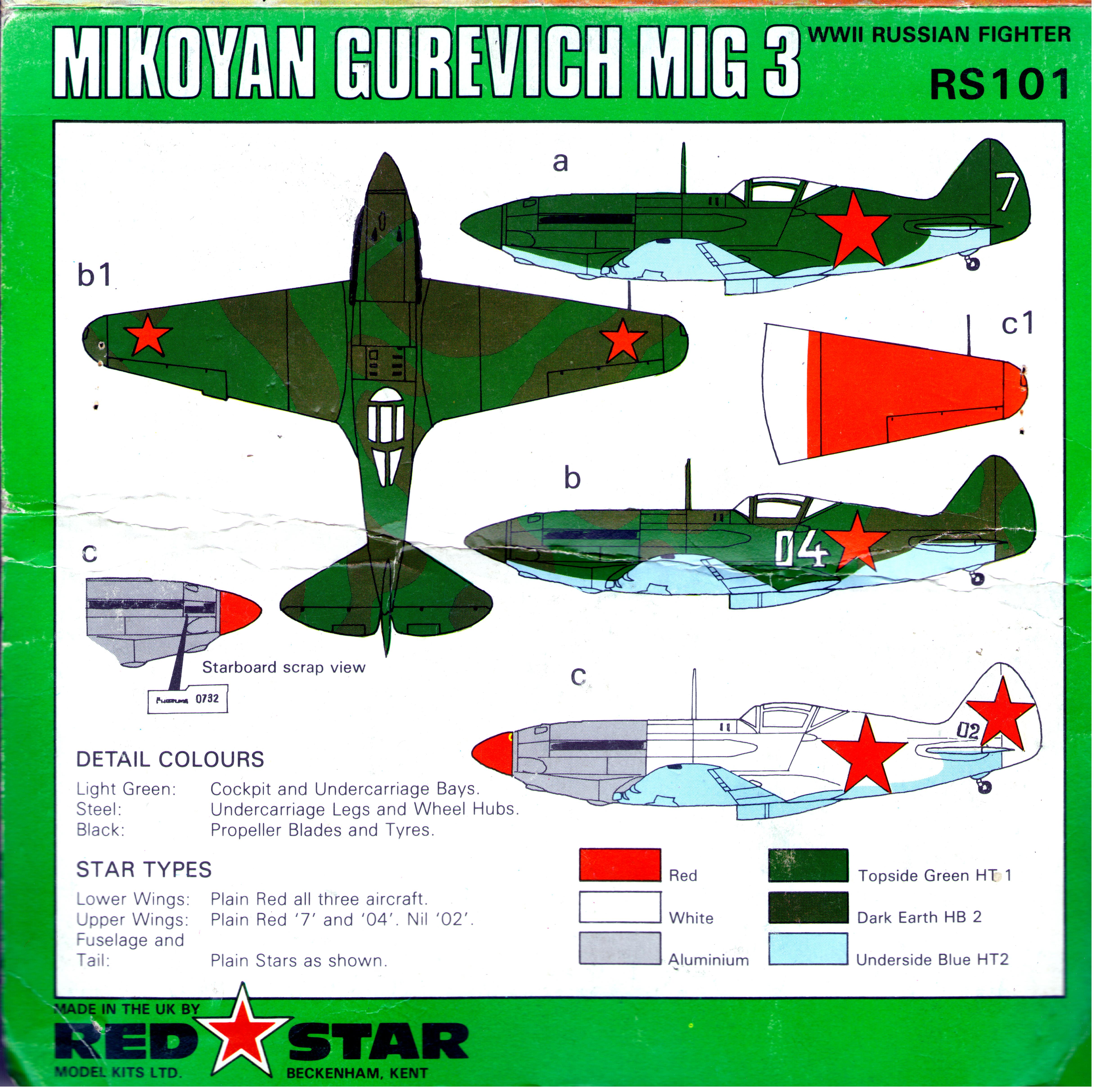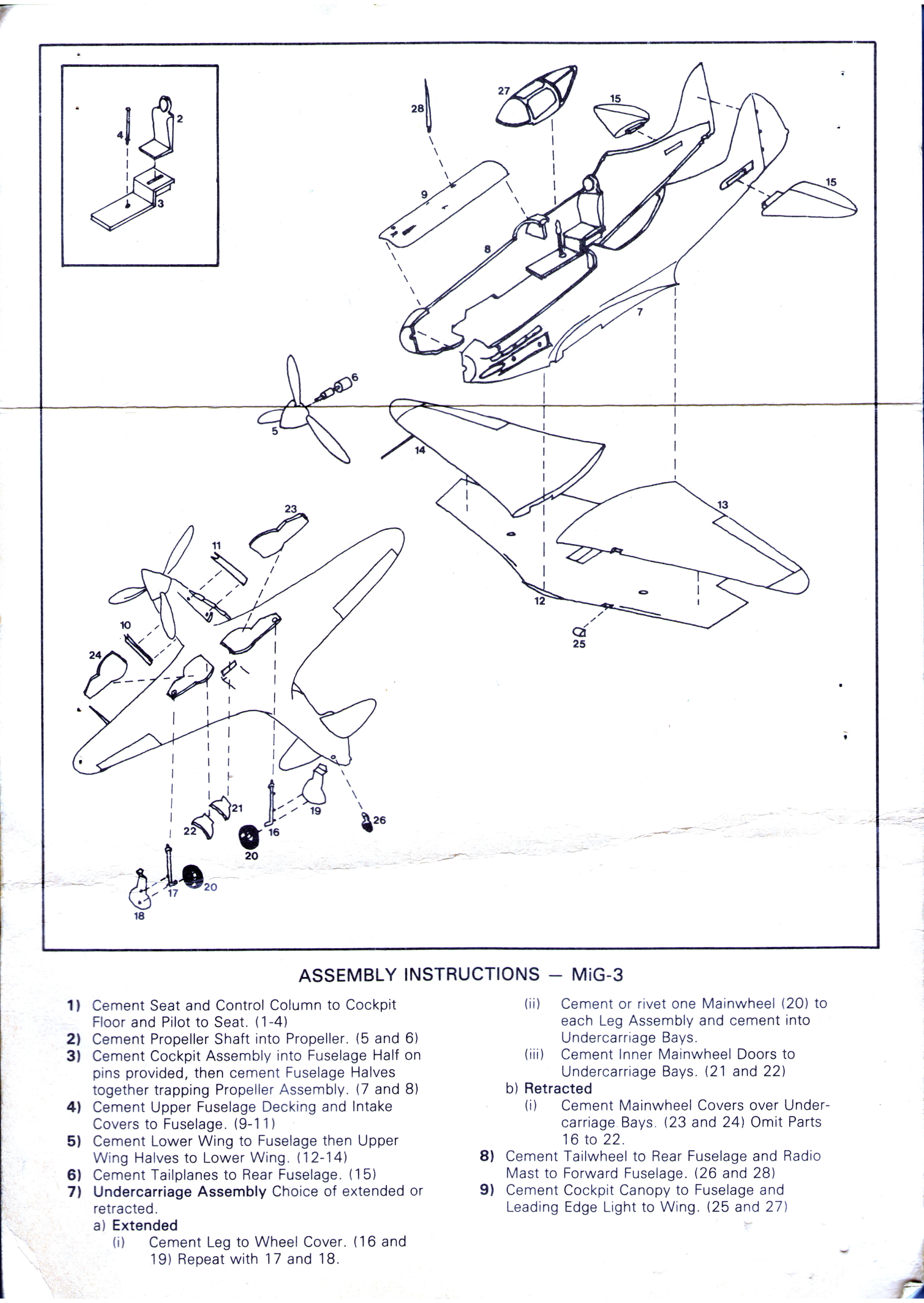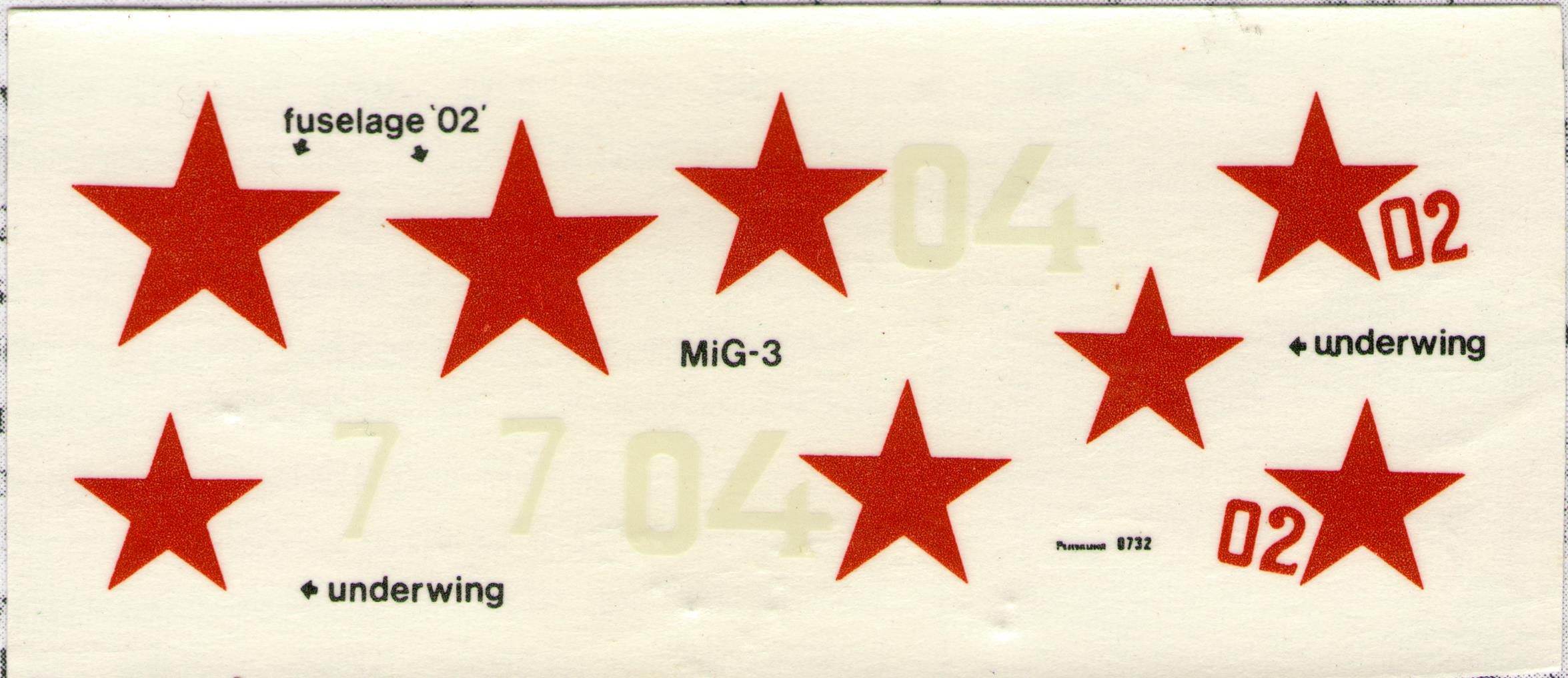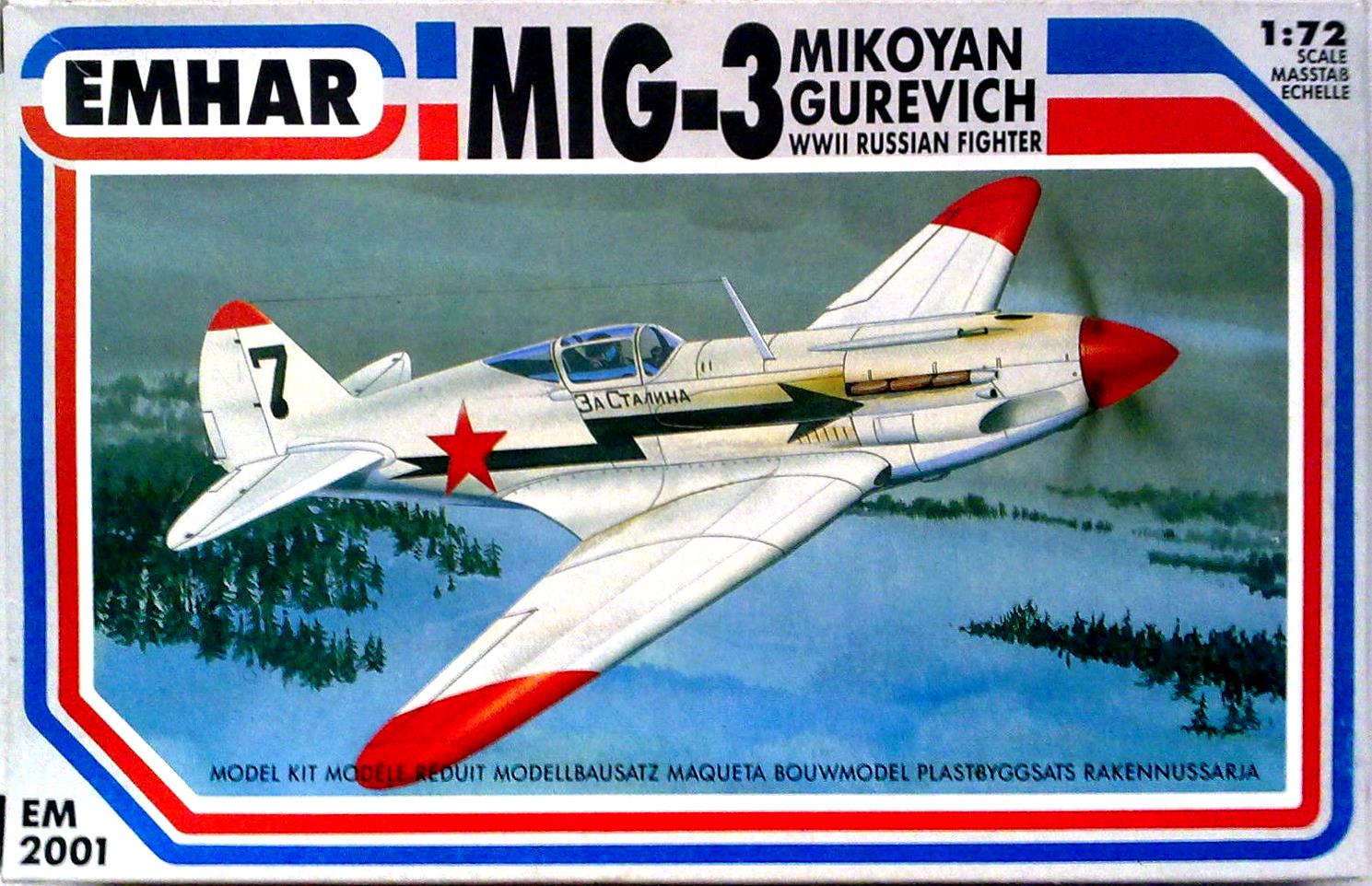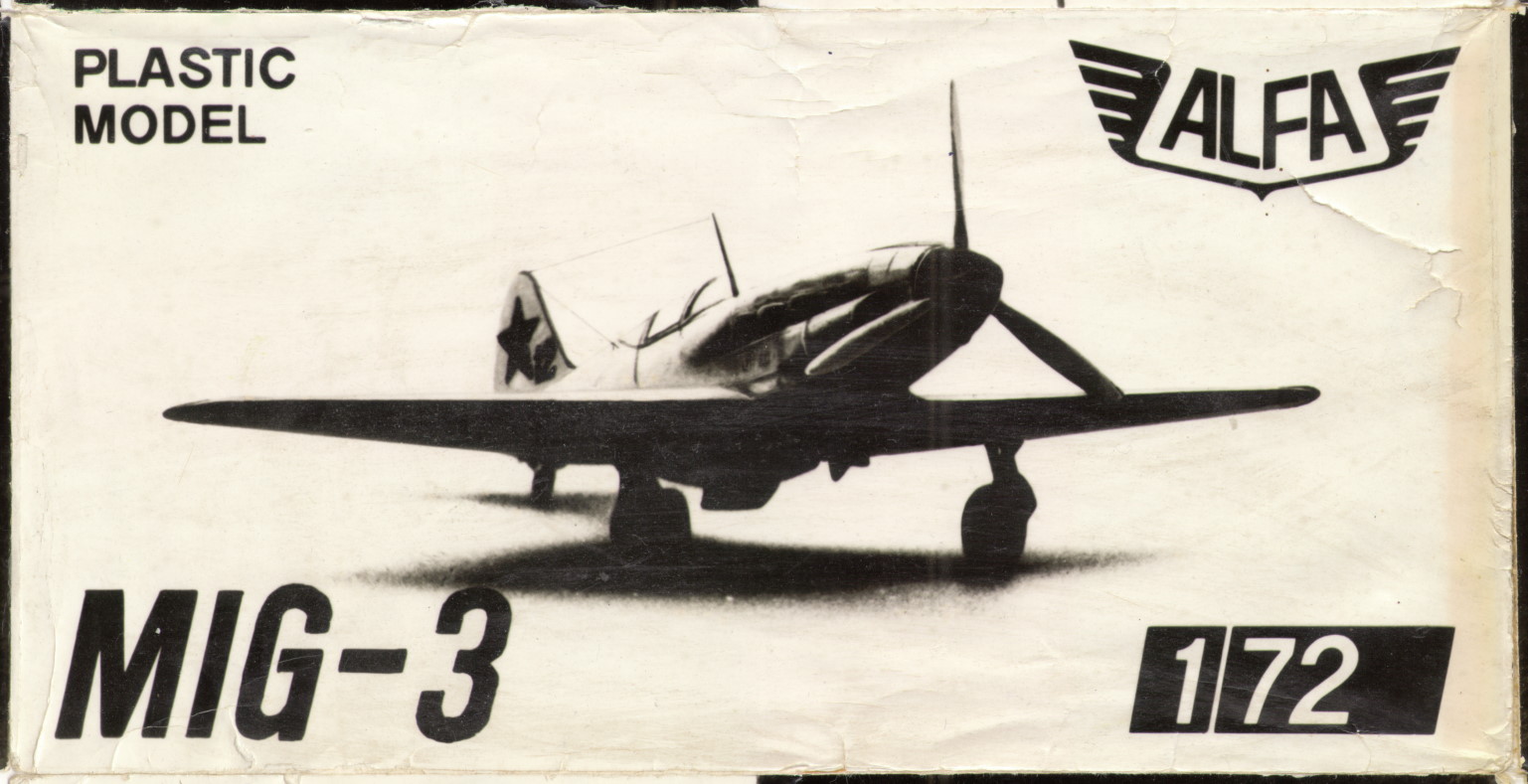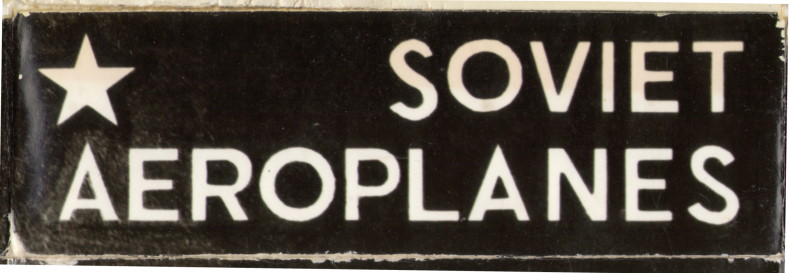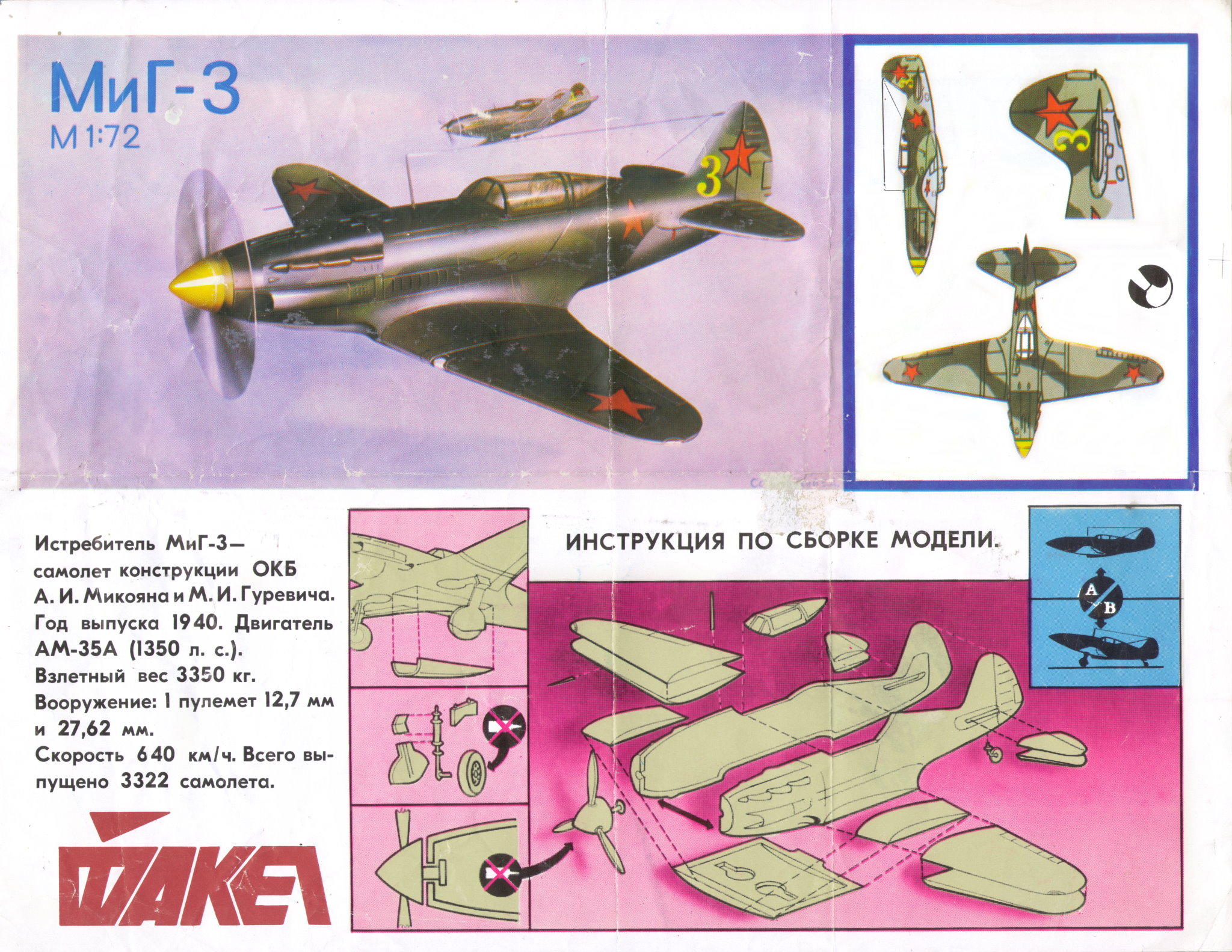
Red Star RS1/4 Mikoyan and Gurevich MiG-3, Red Star Model Kits Ltd,
distributed by CMS Marketing International, 1983, four kits pack


SCALE MODELLERS' MARKET PLACE
MiG-3
Manufacturer: Red Star Model Kits
Scale: 1:72nd
Price: At present only available as a set of four kits (MiG-3, Yak-3, LaGG-3 and Anatra DS 1) at £9.85.
This kit, and that of the Yak-3, was produced by the same people who made the moulds for Frog/Novo kits in days gone by. The size of the frames, the thickness of the plastic and the style of the kit certainly bears all the hallmarks of Frog, even to the reference number.
The review kit was moulded in dark green plastic but I have seen others in the medium grey which was used by Frog for many years.
The fuselage and fin are split vertically but the port side also carries the complete rudder which enables a reasonably thin trailing edge to be achieved without this being too fragile.
Cockpit detail is limited to floor, seat and control column. The propeller has a shaped short pin as a shaft which enables it to revolve when trapped between the fuselage halves once these are glued together.
The top of the fuselage forward of the cockpit, which carries the twin guns, is a separate component, as are the air intakes on either side of the lower nose.
To obtain the correct dihedral for the wing, the underside component has been moulded as one piece out to near the wing tips. The tips themselves are moulded on to the upper wing halves, again to enable a strong but realistically thin outer wing to be achieved. Some care was required in blending in the joint on the underside but the wing roots on the top side fitted quite well. Only a small amount of filler was needed.
There is a choice of having a lowered undercarriage or of modelling it in the up position, one-piece doors being provided. If undercarriage up is required it will be necessary to raid the spares box for a stand as this item is not provided.
Decals in the kit are provided for three colour schemes. I chose the one in Arctic colours, coded '02' of the 12 IAP, which, incidentally, is illustrated in MacDonald's Soviet Air Force Fighters Part 1. Undersides are light blue (Humbrol HT2) and top surfaces white with red outer wings and spinner plus an aluminium engine cowling. The other markings are for '04' with green/brown upper surface camouflage and '7' with green only upper surfaces.
The only real error I could find on the model concerns the canopy to the rear of the opening part of the hood. This should have only a single central frame and not two as suggested.
Brian L. Thorne
Scale aircraft modelling, May 1984, Vol.6 N.9
Red Star
Red Star Model Kits Ltd., 16 Whitecroft Road, Beckenham, Kent, England BR3 3AG
Period: 1983 to date
Of the 169 Frog moulds completed from 1955 to 1977, only six are believed still to remain in Great Britain. Two of these (the Dennis Ambulance and Firefly Dinghy moulds) are with Hornby Hobbies and the other four with Red Star.
These four are the so-called "Russian" moulds completed by Rovex specifically for use in the USSR, but in the end never sent there. After several attempts to sell them to established kit producers, the Novo receivers finally found a buyer in the Red Star company; a small firm with a rather unusual story behind it.
The story of Red Star goes back to 1982 when Jim Chapman — the subsequent founder of Red Star — took a holiday in the Soviet Union. Before departure he made enquiries to discover where he might be able to purchase kits for his own use. Before he left he heard from the relevant Soviet authority, who also advised him that the possibility of importing a range of ex-Frog kits to the West was under active consideration.
On his return home, he contacted the Soviet import agency with a view to offer advice on the proposed import project. The initial advice took the form of a review of the alternative kits available. This led to further meetings where it became obvious that the agents had rather vague ideas on the choice of suitable kit subjects and not much practical knowledge on matters such as packaging and decals (at one point a peel-off/stick-on type of markings was seriously considered, and some test sheets on white backing paper were printed!). The question of finding a suitable distributor was also pending, but in the end the agents choose Capital Models Supply (CMS). See Novoexport for more details of this operation.
During his enquiries for the CMS import project, Jim discovered the existence of the four moulds later acquired by Red Star. Initially he was asked to cost a scheme to acquire and market these moulds as an ancillary project to the main import scheme. Although his report showed this to be feasible, the Soviets did not wish to proceed until the main scheme was well under way.
As by this time he had invested a considerable amount of effort in the project, Jim Chapman was however reluctant to see the moulds disappear to Eastern Europe. He therefore put forward a proposal to a number of people to see if a consortium could be put together to handle the moulds without Soviet involvement. After a number of false starts and changes in the expected participants, a company was arranged to handle the scheme. This was Glenprime Ltd., but the name was soon changed to Red Star Model Kits Ltd.
By July 1983 they were ready to go into production and on October 31st CMS - who had been appointed sole distributor - took delivery of the first 3,000 of the 7.000 four-kit sets ordered by them. In the event, only about 2.000 of these were sold as sets, the balance being repacked singly in polythene bags with header cards, mainly to meet US orders received by CMS in the spring of 1984. Most sets had a red and white label, but a few of the last ones sold after October 1984 had this replaced by a photocopy.
After CMS went into receivership in August 1984, attempts to get the intended backers of CMS' Soviet import scheme to continue were unsuccessful. Jim then put forward various schemes whereby the Soviets could act as their own distributors for at least a limited scheme. When none of these proposals had elicited much of a response by March 1985, Red Star offered to run such a project on behalf of the Soviets and - to ensure that there was no financial risk to the Soviets — offered to surrender Red Star's moulds as payment. This scheme was initially accepted but then the Soviets changed their mind and progress stopped. Other proposals covered an exchange of moulds to enable production to take place in England but this was also turned down.
Finally a simple offer to purchase kits for cash was put forward. This was accepted in December 1985 and an initial range of nine kits (all from the DFI factory) was agreed upon. Of these, the Maryland was subsequently dropped as a small mould defect was found. It was hoped that a further sixteen types (including the Sea Venom and Whitley) would follow later. In addition, the Soviets offered delivery of 1,000 Shackletons from existing stocks.
But nothing has happened since and Red Star are still waiting for their kits. Apparently the Soviets developed cold feet at the last moment and the future of the deal is somewhat uncertain. It is possible that the recent large exports to Eastern bloc countries (to pay for food imports to the nuclear stricken Ukraine) has taken up much of the available capacity. There are two hopeful signs, however. The first is the Soviets' undeniable interest in acquiring the Red Star moulds. The second is the recent changes in Soviet hierarchy. Fresh approaches have recently been made so there is still hope. . .
In anticipation of the first Soviet deliveries, Red Star commissioned new artwork for the Skua, Vengeance and Ventura. In addition, new decals were designed for the Skua and Ventura. This work was done by Dick Ward of Modeldecal, who also did the previous Red Star decals. Meanwhile, production of the first four kits was (temporarily) suspended in March 1987. By then, total production was as follows: MiG-3 12,500, LaGG-3 11,500, Anatra 9,500 and Yak-3 8,500 pieces. Mould problems have necessitated a few small adjustments, as can be seen when comparing with samples produced by Rovex. A small batch of review samples was made in translucent white and bulk production in medium grey.
FROG model aircraft 1932-1976, R. Lines, L. Hellstrom"
| 


